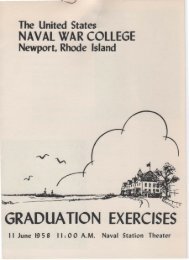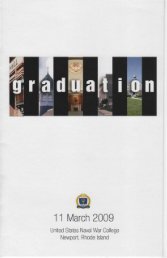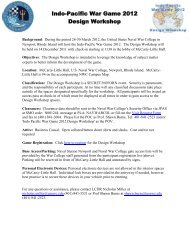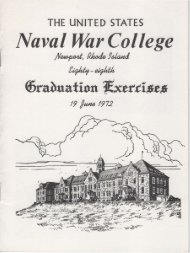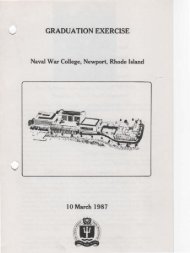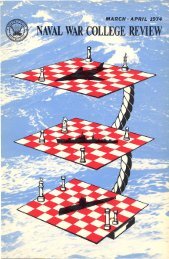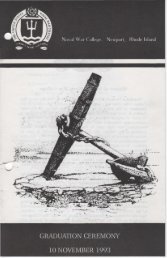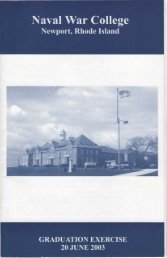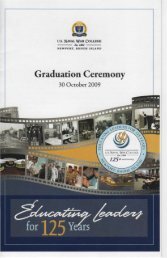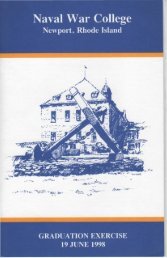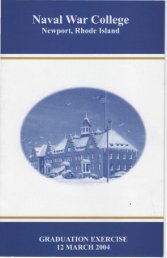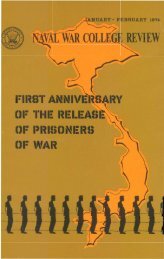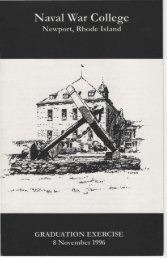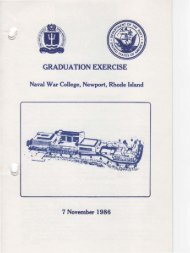Graduation Ceremony - US Naval War College
Graduation Ceremony - US Naval War College
Graduation Ceremony - US Naval War College
Create successful ePaper yourself
Turn your PDF publications into a flip-book with our unique Google optimized e-Paper software.
u.s. NAVAL WAR COLLEGE<br />
--- Est. 1884 ---<br />
NBWPORT, RHODB ISLAND<br />
<strong>Graduation</strong> <strong>Ceremony</strong><br />
1 March 2011<br />
Building the Foundations of Leadership
On the cover: The building depicted on the face of this<br />
slate is known as Luce Hall and was constructed in 1892<br />
as the first purpose-built building for the u.S. <strong>Naval</strong> <strong>War</strong><br />
<strong>College</strong>, founded in 1884. It was designed by a Newport<br />
architect, George Champlin Mason. Congress appropriated<br />
funds for the project and it was originally conceived<br />
as a multi-purpose building housing officers' quarters,<br />
classrooms, the library, and other administrative offices.<br />
Captain Alfred Thayer Mahan was the first to occupy the<br />
building as President of the <strong>Naval</strong> <strong>War</strong> <strong>College</strong>.<br />
Over the years, work has been done to update the interior<br />
of Luce Hall. It was rededicated in 1934 and named for<br />
RADM Stephen B. Luce, the aval <strong>War</strong> <strong>College</strong>'S founder<br />
and first president (1884-1886). In 1964, the building was<br />
designated a National Historic Landmark.<br />
During the 2009-10 renovation of Luce Hall, the original<br />
1892 historic roof slates were replaced and many were<br />
engraved with the image of this historic landmark for<br />
presentation. Luce Hall will reopen this month.
HISTORY OF THE U.S. NAVAL WAR COLLEGE<br />
Founded in Newport, Rhode Island, on October 6, 1884, the <strong>Naval</strong> <strong>War</strong><br />
<strong>College</strong> is the oldest war college in the nation, and the first military service<br />
institution in the world to be designated a war college. Commodore<br />
Stephen B. Luce was the first president and organized the <strong>War</strong> <strong>College</strong> as<br />
"a place of original research on all questions relating to war and the<br />
statesmanship connected with war, or the prevention of war." These<br />
foundations were built upon by Captain Alfred Thayer Mahan, second<br />
president of the <strong>College</strong>, who had originally been selected by Luce to<br />
initiate the course in <strong>Naval</strong> History. Of all the men who were to influence<br />
the institution in its early years, none was to have a more profound impact.<br />
Mahan's views deeply affected such leaders as Henry Cabot Lodge and<br />
Theodore Roosevelt and through them and others helped shape the<br />
United States' destiny at the turn of the century. Mahan's writings,<br />
published as The Illfluence of Seapower Upon History, 1660-1783, gained<br />
him worldwide acclaim and established the <strong>Naval</strong> <strong>War</strong> <strong>College</strong> as an<br />
internationally respected institution.<br />
Functioning continuously since 1884, except for brief periods during<br />
the Spanish-American <strong>War</strong> and World <strong>War</strong> I, the <strong>War</strong> <strong>College</strong> numbers<br />
among its graduates such distinguished naval officers as Admirals Sims,<br />
Spruance, King, Nimitz, and Halsey, in addition to many others who today<br />
are holding prominent military positions.<br />
The work begun more than one hundred years ago by Luce and Mahan<br />
continues today. As graduates well know, the curriculum is both demanding<br />
and rewarding. For the military professional, the unique education provided<br />
by the <strong>Naval</strong> <strong>War</strong> <strong>College</strong> is unrivaled. In recognition of the academic<br />
rigor and educational excellence of its program, the <strong>Naval</strong> <strong>War</strong><br />
<strong>College</strong> was accredited in 1991 by the New England Association of Schools<br />
and <strong>College</strong>s to award a Master of Arts Degree in National Security and<br />
Strategic Studies. .
THE ACADEMIC PROCESSION AND REGALIA<br />
For centuries, institutions of higher learning have dignified their<br />
ceremonies with an academic procession, a custom descending from the<br />
clerical procession. The procession is led by a marshal, followed by the<br />
student body and the academicians or faculty, attired in the robes prescribed<br />
for their respective degrees. Distinguished visitors and delegates follow the<br />
faculty, and last in the procession comes the president of the institution.<br />
Each member of an academic procession ordinarily wears a cap, gown,<br />
and hood. In the procession today military faculty will not wear academic<br />
gowns. The earliest illustration of gowns worn at Oxford University<br />
somewhat resembles cassocks worn by English teachers who found good use<br />
for the hood, or cowl, as protection against the weather. A uniform<br />
American system of academic heraldry displays the level of degree, the field<br />
of study in which it was earned, and the institution by which it was granted.<br />
It is the hood which provides academic regalia its color and offers the most<br />
information about its wearer. The silk lining of the hood bears the color, or<br />
colors, of the degree-granting college or university; its velvet facing reveals the<br />
color assigned to each area of study. The Bachelor's gown is relatively simple,<br />
falling in straight lines from an elaborate yoke and having pointed sleeves. The<br />
Master's gown is slightly more elaborate and fastens about the wrist. The<br />
Doctor's gown is marked by velvet panels down the front and around the<br />
neck, as well as by three bars of the same material on the well-shaped sleeves.<br />
It is cut more fully and may be ornamented. The hood worn is three feet in<br />
length for Bachelors, three and one-half feet for Masters, and four feet for<br />
Doctorates, with velvet trimming of tvvo, three, and five inches in width<br />
respectively.<br />
The edging, or facing, velvet of academic hoods indicates the area of study.<br />
The principal scholarly fields seen in the procession today include:<br />
Philosophy<br />
Arts, Letters, Humanities<br />
Business Administration<br />
Economics<br />
Engineering<br />
Law<br />
International Affairs/Public Administration<br />
Dark Blue<br />
White<br />
Light Brown<br />
Copper<br />
Orange<br />
Purple<br />
Peacock Blue<br />
The American mortarboard, derived from the soft Oxford cap, is black.<br />
Its tassel, for holders of the bachelor's and master's degree, is usually black,<br />
while gold tassels are worn by holders of doctoral degrees and heads of<br />
institutions. The tassel is worn on the right side of the cap by<br />
undergraduates, on the left by holders of bachelor's and higher degrees.
PROGRAM<br />
Master of Ceremonies<br />
Captain Raymond F. Keledei, U.S. Navy<br />
Dean of Students<br />
Procession of Students<br />
Arrival of Official Party"<br />
National Anthem"<br />
Mrs. Julie Zecher<br />
Acquisitions Librarian, Henry E. Eccles Library<br />
Invocation"<br />
Captain Brenda F. BradleyDavila, CHC, u.S. Navy<br />
CoUege of <strong>Naval</strong> <strong>War</strong>fare, Class of2011<br />
Introduction of Guest Speaker<br />
Colonel James C. Brennan, U.S. Marine Corps<br />
CoUege of <strong>Naval</strong> <strong>War</strong>fare, Class of2011<br />
<strong>Graduation</strong> Address<br />
Professor William J. Hartig<br />
Joint Military Operations<br />
Presentation of Diplomas<br />
Charge to Graduates<br />
Rear Admiral James P. «Phil" Wisecup, U.S. Navy<br />
President, u.S. <strong>Naval</strong> <strong>War</strong> <strong>College</strong><br />
Benediction"<br />
Captain Brenda F. BradleyDavila, CHC, U.S. Navy<br />
<strong>College</strong> of <strong>Naval</strong> <strong>War</strong>fare, Class 0[2011<br />
"Guests please stand
Rear Admiral James P. "Phil" Wisecup<br />
President, u.s. <strong>Naval</strong> <strong>War</strong> <strong>College</strong><br />
Rear Admiral James "Phil" Wisecup became<br />
the filly-second President of the u.s. <strong>Naval</strong> <strong>War</strong><br />
<strong>College</strong> on 6 November 2008. He most recently<br />
served as Commander, Carrier Strike Group 7<br />
(Ronald Reagan Strike Group), returning from<br />
deployment in October 2008.<br />
A 1977 graduate of the u.S. <strong>Naval</strong> Academy,<br />
Wisecup earned his master's degree in international<br />
relations from the University of Southern<br />
California, graduated from the <strong>Naval</strong> <strong>War</strong> <strong>College</strong><br />
in 1998, and also earned a degree from the Uni~ersity of Strasbourg, France, as an<br />
Olmsted Scholar, in 1982.<br />
At sea, he served as executive officer of<strong>US</strong>S Valley Forge (CG 50) during Operation<br />
DESERT STORM. As Commanding Officer, <strong>US</strong>S Callaghan (DDG 994), he<br />
was awarded the Vice Admiral James Stockdale Award for Inspirational Leadership.<br />
He served as Commander, Destroyer Squadron 21 during Operation<br />
ENDURING FREEDOM after 9/1l.<br />
Ashore, he was assigned to NATO Headquarters in Brussels, Belgium; served<br />
as Force Planner and Ship Scheduler for Commander, U.S. <strong>Naval</strong> Surface Forces,<br />
Pacific; and served as action officer for Navy Headquarters Plans/Policy Staff. He<br />
served as a fellow on the Chief of <strong>Naval</strong> Operations Strategic Studies Group; as<br />
Director, White House Situation Room; and as Commander, u.S. <strong>Naval</strong> Forces<br />
Korea.<br />
Wisecup's awards include the Defense Superior Service Medal, Legion of<br />
Merit, Bronze Star, and various unit, service, and campaign awards.
Professor William J. Hartig<br />
Joint Military Operations,<br />
U.S. <strong>Naval</strong> <strong>War</strong> CoUege<br />
Professor BiU Hartig initially reported to the<br />
Joint Military Operations Department as an active<br />
duty Marine infantry officer in July 2004, following<br />
a tour as Assistant Chief of Staff, for the I Marine<br />
Expeditionary Force. He served in all three<br />
Marine Expeditionary Forces and commanded at<br />
each grade. He retired as a Marine Colonel on<br />
1 October 2007 after 30 years of service and joined<br />
the faculty as Professor and as the ]MO JPME<br />
Phase 2 Coordinator.
Ambassador Mary Ann Peters (ret.)<br />
Provost, U.S. <strong>Naval</strong> <strong>War</strong> <strong>College</strong><br />
Ambassador Peters became th~ fourth Provost<br />
of the <strong>Naval</strong> <strong>War</strong> <strong>College</strong> on 18 September 2008.<br />
Previously, she held the position of Dean of Academics<br />
of the <strong>College</strong> of International and Security<br />
Studies at the George C. Marshall European<br />
Center for Security Studies in Garmisch<br />
Parten kirchen, Germany. Prior to becoming the<br />
Dean of the <strong>College</strong>, Ambassador Peters served as<br />
Associate Director for International Liaison at the<br />
Marshall Center.<br />
Before joining the Marshall Center in 2003, Ambassador Peters spent more<br />
than 30 years as a career diplomat with the U.S. Department of State. From 2000<br />
to 2003 Ambassador Peters served as the U.S. Ambassador to Bangladesh, leading<br />
the Mission's efforts in support of the war on terrorism and other key U.S. foreign<br />
policy goals. She received a Presidential Meritorious Service Award in 2003 for her<br />
work in Bangladesh. Prior to her posting in Dhaka, Ambassador Peters was the<br />
Deputy Chief of Mission at the United States Embassy in Ottawa, Canada, responsible<br />
for the management of the Embassy and supervision of the six U.S.<br />
Consulates General in Canada.<br />
From 1995 to 1997, Ambassador Peters served in the White House as Director<br />
for European and Canadian Affairs at the National Security Council. Among<br />
other portfolios in this position, Ambassador Peters worked on the diplomatic<br />
and security aspects of the search for peace in Northern Ireland. From 1993 to<br />
1994, Ambassador Peters served as Deputy Assistant Secretary of State with oversight<br />
responsibility for U.S. relations with 19 Western European countries and<br />
Canada. In this capacity she acted as the U.S. Chair of the U.S.-Canada military<br />
coordination body, the Permanent Joint Board on Defense.<br />
A senior diplomat, fluent in six foreign languages, Ambassador Peters has also<br />
served in Sofia, Bulgaria, as Deputy Chief of Mission; in Moscow as Economic<br />
Counselor; and in Mandalay, Burma, as Principal Officer. Prior to her assignment<br />
in Moscow, she studied Russian at the U.S. Army Russian Institute in Garmisch,<br />
Germany. From 1988 to 1990, Ambassador Peters was the Deputy Director of the<br />
Office of Pakistan, Afghanistan and Bangladesh Affairs in the U.S. State Department.<br />
She began her career as a Vice-Consul in Frankfurt in 1975.<br />
Ambassador Peters holds a Bachelor of Arts degree from Santa Clara University<br />
and a Masters in International Studies from the School of Advanced International<br />
Studies at The Johns Hopkins University. Her formal education also<br />
included course work in Paris, France, and Bologna, Italy.
Dr. John F. Garofano<br />
Dean of Academic Affairs<br />
U.S. <strong>Naval</strong> <strong>War</strong> <strong>College</strong><br />
John Garofano is Dean of Academic Affairs,<br />
U.S. <strong>Naval</strong> <strong>War</strong> <strong>College</strong>, Newport, RI. Previously<br />
he was Professor, Strategy and Policy Department,<br />
and Professor, National Security Decision<br />
Making Department, U.S. <strong>Naval</strong> <strong>War</strong> <strong>College</strong>. He<br />
received the Ph.D. in Government from Cornell<br />
University and an M.A. from the Johns Hopkins<br />
School of Advanced International Studies (Bologna/<br />
Washington).<br />
Dr. Garofano's research interests include military intervention, Asian security,<br />
and the making of U.S. foreign policy. His writings include The Intervention Debate:<br />
Towards a Posture of Principled Judgment (Carlisle, PA: 2002), Clinton's Foreign<br />
Policy: A Documentary Record (ed., Kluwer, 2003), and articles in<br />
International Security, Asian Survey, Contemporary Southeast Asia, Orbis and the<br />
<strong>Naval</strong> <strong>War</strong> <strong>College</strong> Review, among other journals.<br />
Prior to joining the <strong>War</strong> <strong>College</strong>'s faculty, Dr. Garofano has been aSenior Fellow<br />
at the Kennedy School of Government and a Professor at the U.S. Army <strong>War</strong><br />
<strong>College</strong>, the Five <strong>College</strong>s of Western Massachusetts, and the University of Southern<br />
California. Currently, he holds the Jerome Levy Chair of Economic Geography<br />
and National Security, and is an Area of Study Coordinator for Asia-Pacific<br />
electives.
Professor William R. Spain<br />
Associate Provost, U.S. <strong>Naval</strong> <strong>War</strong> <strong>College</strong><br />
Since 2001, Bill Spain has 'been involved in<br />
nearly every aspect of the U.S. <strong>Naval</strong> <strong>War</strong> <strong>College</strong><br />
and Navy professional military education (PME),<br />
assisting five consecutive Presidents and four Provosts<br />
with the <strong>Naval</strong> <strong>War</strong> <strong>College</strong>'s academic programs,<br />
implementing the CNO's professional<br />
military education continuum, developing the<br />
Navy's Path to Jointness, and devising a systemic<br />
approach to embedding regional and cultural education<br />
throughout Navy PME. His principal duties<br />
include assessing the <strong>College</strong>'s institutional effectiveness across all of its<br />
mission functions. Under his leadership, the <strong>College</strong> conducts continuous selfassessment<br />
and has published eight self-studies in the last decade. He also manages<br />
the <strong>College</strong>'s Strategic Plan and contributes significantly to the development<br />
and management of the <strong>College</strong>'s resources. He also teaches two courses in the<br />
Elective program-American Foreign Policy in the 20th CentlLrY and the American<br />
Revolutionary <strong>War</strong> & the Colonial Military Tradition.<br />
Professor Spain has led successful Department of Defense-mandated joint<br />
professional military education accreditation efforts of the <strong>College</strong> of <strong>Naval</strong> <strong>War</strong>fare,<br />
the <strong>College</strong> of <strong>Naval</strong> Command and Staff, and the <strong>College</strong> of Distance Education<br />
in 1998, 2003, 2007 and 2009. He routinely serves as a member of the<br />
Chairman, Joint Chiefs of Staff Accreditation Team for Joint Professional Military<br />
Education. In 2005, he successfully led the <strong>College</strong>'s effort for the New England<br />
Association of Schools and <strong>College</strong>s reaccreditation for the Master of Arts in<br />
National Security and Strategic Studies.<br />
Before he retired from the United States Marine Corps, Colonel Spain served<br />
as the Chairman, Joint Military Operations Department, the Special Assistant to<br />
the Dean of Academics for Joint Professional Education, and the H. M. Smith<br />
Chair of Expeditionary <strong>War</strong>fare at the <strong>Naval</strong> <strong>War</strong> <strong>College</strong>. During his thirty years<br />
of active service, he commanded in three of the four Marine Corps divisions and<br />
served in all four.<br />
Professor Spain's civilian education includes an MIT fellowship for Seminar<br />
XXI, doctoral studies and an M.A. in International Relations from Salve Regina<br />
University, and a B.A. in History from Randolph-Macon <strong>College</strong>. His military<br />
schools include the <strong>College</strong> of <strong>Naval</strong> <strong>War</strong>fare at the <strong>Naval</strong> <strong>War</strong> <strong>College</strong>, the <strong>US</strong>MC<br />
Command and Staff <strong>College</strong>, the Advanced and Basic Officers Field Artillery<br />
COlLrses, and the Marine Corps Basic School.<br />
Professor Spai n has been awarded the Departmen t of the Navy Su perior Civilian<br />
Service and Meritorious Civilian Service Awards. In 2009, Bill received the<br />
Bud Gifford Leadership Award recognizing him as Rhode Island's Federal<br />
Supervisor-of-the-Year. .<br />
Professor Spain and his wife, Nancy, work in Newport, Rhode Island. Their<br />
three adult children are scattered across this great nation. Their mother, Mrs.<br />
Ruth Splichal, lives with them in Portsmouth, Rl.
COLLEGE OF NAVAL WARFARE '<br />
Colonel Gino P. Amoroso, U.S. Marine Corps<br />
. Captain Brenda F. BradleyDavila, CHC, U.S. Navy<br />
Colonel James c. Brennan, U.S. Marine Corps<br />
Commander Christopher P. Brown, U.S. Navy<br />
Commander Robert E. Burke, U.S. Navy<br />
Colonel Douglas C. Cardinale, U.S. Army<br />
Captain Conrad D. David, U.S. Navy<br />
Commander Daniel T. Dolan, U.S. Navy<br />
Lieutenant Commander Charles R. Dwy, SC, U.S. Navy<br />
Commander Jason c. Eaton, U.S. Navy<br />
Lieutenant Commander Joseph A. Gagliano, U.S. Navy<br />
Commander Kendall Gennick, U.S. Navy<br />
Commander Craig M. Gummer, U.S. Navy<br />
Commander Robert J. Hallahan, U.S. Navy<br />
Commander Ryan J. Heilman, U.S. Navy<br />
Captain Kurt A. Henry, MC, U.S. Navy<br />
Commander Mery-Angela S. Katson, U.S. Navy<br />
Commander Gregory D. Knepper, U.S. Navy<br />
Lieutenant Colonel James c. Lewis, U.S. Marine Corps<br />
Commander Joseph S. Martin, U.S. Navy<br />
Commander Maryann C. Mattonen, NC, U.S. Navy<br />
Captain Kenneth 1. Merrick, U.S. Navy<br />
Commander Robert J. Michael, U.S. Navy<br />
Commander William T. Miller, U.S. Navy<br />
Lieutenant Commander Mark C. Newkirk, U.S. Navy<br />
Lieutenant Commander Steven E. Oseland, U.S. Navy<br />
Commander David M. Overcash, U.S. Navy<br />
Commander Aristides G. Reyes, U.S. Navy<br />
Commander Mark A. Scorgie, U.S. Navy<br />
Commander Kelly M. Shekitka, U.S. Navy<br />
Commander Thomas H. Shugart III, U.S. Navy<br />
Commander Richard M. Stacpoole, U.S. Navy<br />
Commander Mark G. Standage, U.S. Navy<br />
Commander Douglas A. Thien, U.S. Navy<br />
Commander John A. Thompson, U.S. Navy<br />
Lieutenant Colonel Michael J. Waters, U.S. Air Force
.. ... .....<br />
e \<br />
~<br />
U.S. NAVAL WAR COLLEGE<br />
Est 1884 ----<br />
NEWPORT, RHODE ISLAND<br />
686 Cushing Road<br />
Newport, Rhode Is/and 02841<br />
www.usnwc.edu<br />
Also search for us on Facebook and Twitter



